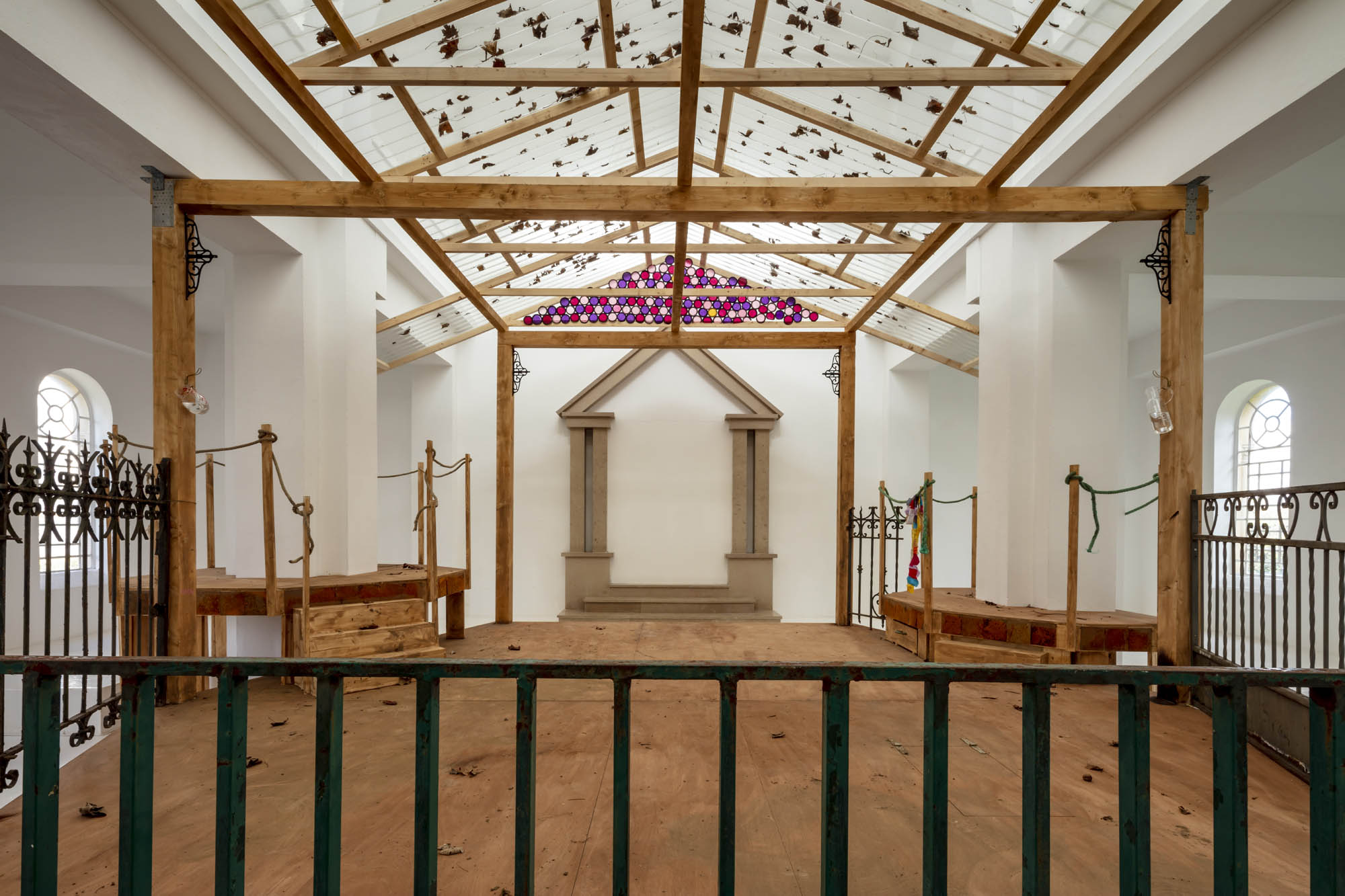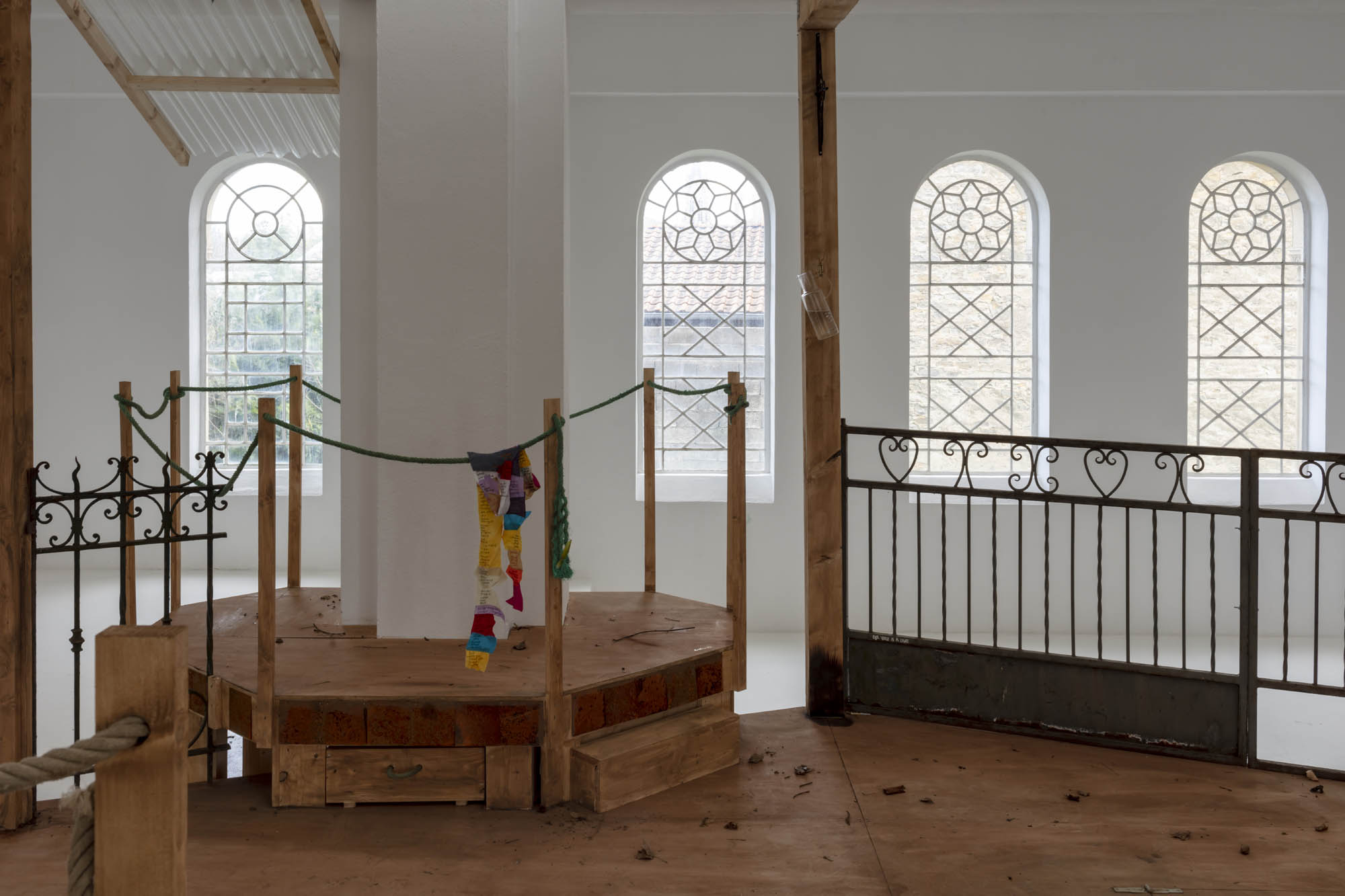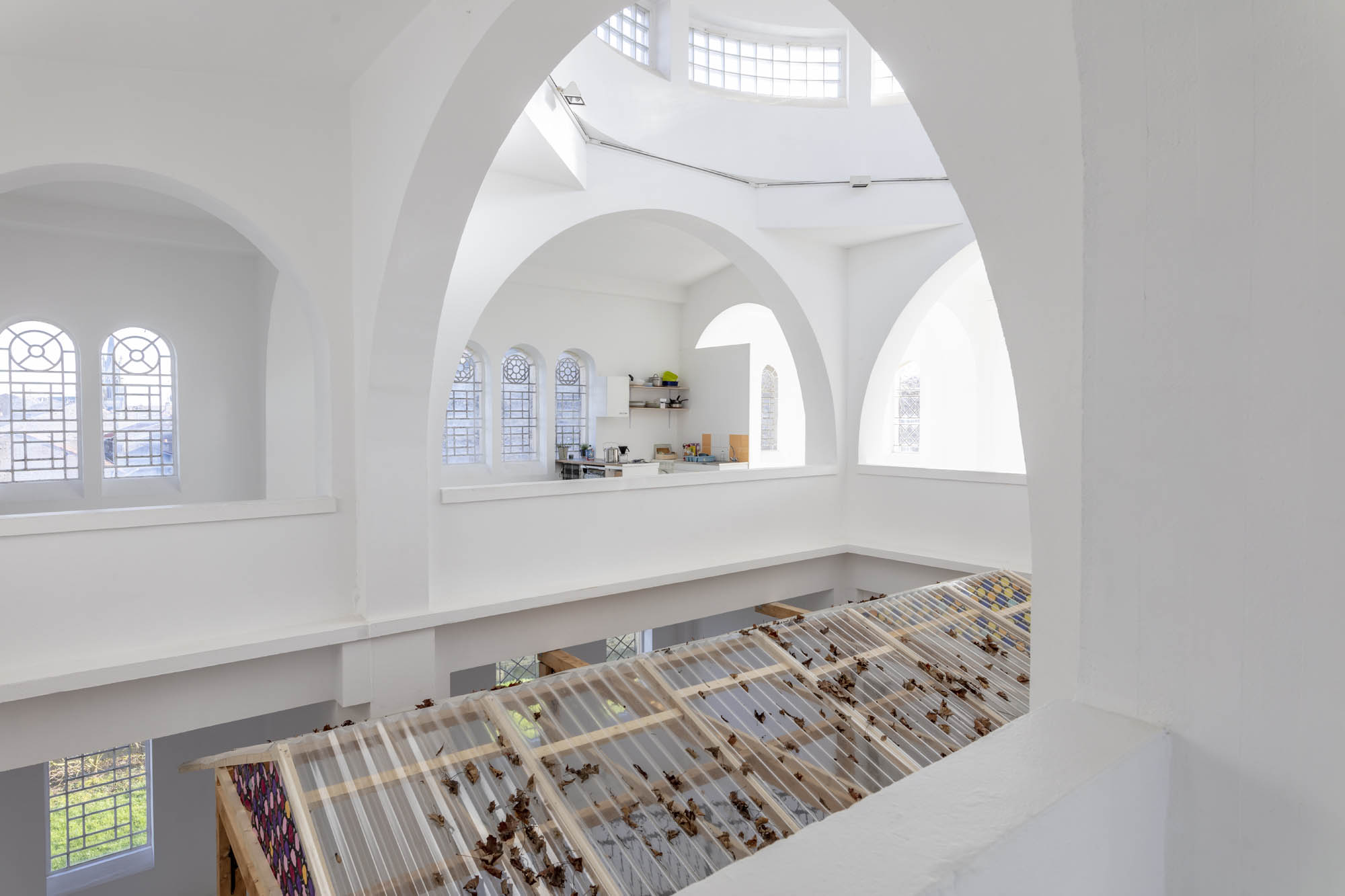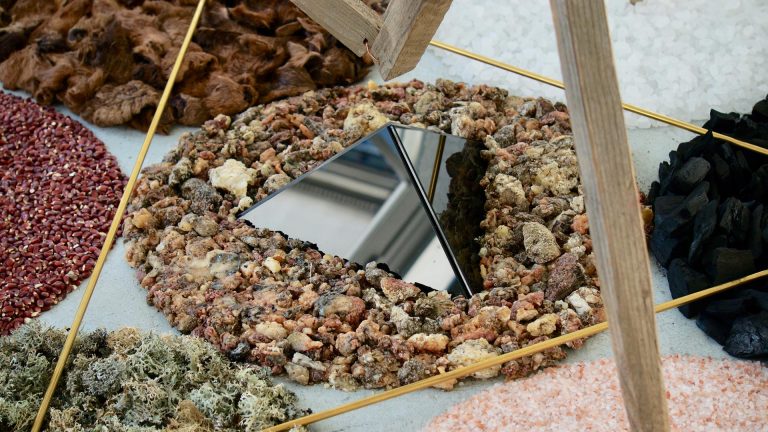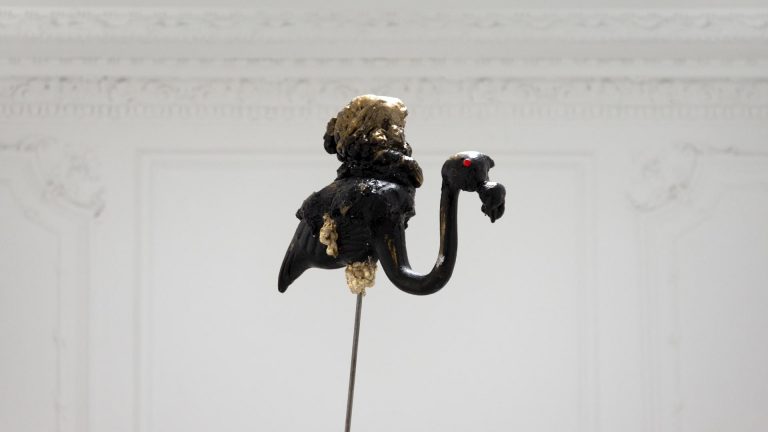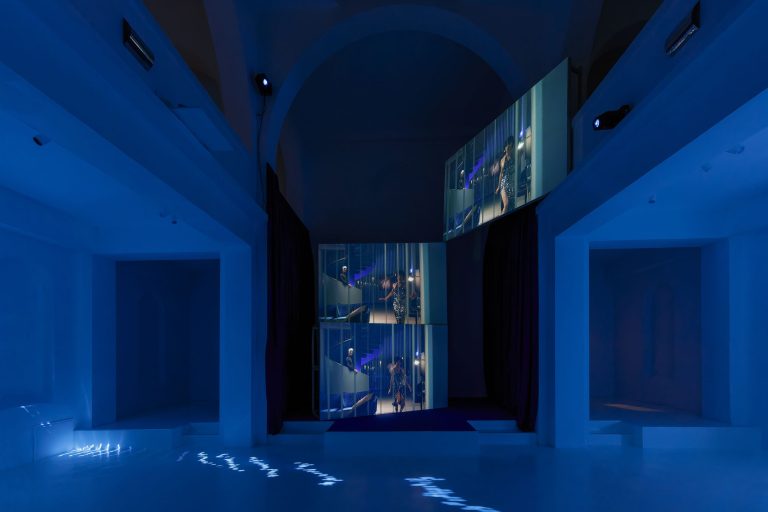Artist: Emily Jones
Exhibition title: as a bird would a snake
Venue: Centre d’art contemporain-la synagogue de Delme, Delme, France
Date: March 9 – May 26, 2019
Photography: all images copyright and courtesy of the artist and Centre d’art contemporain-la synagogue de Delme
The work of Emily Jones (United Kingdom, 1987) operates at the junction of multiple fields : science, ecology, cosmology, architecture, technology, archaeology, geography, as well as history, memory and belief, which are viewed as interconnected strata. These different fields of knowledge intersect and merge within living environments made to be experimented with, like landscapes both physical and mental, in which language and matter—often organic, alive and evolving for the duration of the exhibition —inhabit the space, each activating its own invocatory power. Her environments are populated by objects (like toys, embroideries, fruits and vegetables, architecture), evoking a certain ecological, social or historical reality of a complex world, in which all apparently stable definitions seem to get shattered and reconfigured. They reflect the fluid, constantly evolving reality of a world built over time by a certain ideology, as if unalterably.
The artist’s work also conceives the exhibition not so much as a series of works to observe, but rather a ‘set of entities’ that, once connected, generate a liminal dimension similar to that of a ritual, namely, that moment of unease and confusion, the interzone attained during a rite of passage, which she conceives as a fundamentally vital position. Embodying these constant changes and interactions, these ‘sets of entities’ are often accompanied by elements of raw, sanitised language, used not only for their visual quality—their cold graphic design, as if extracted from office-automation software—but also for the reality they evoke, the image they produce in people’s minds. Language and matter act in a constant to-and-fro between reality and sign, abstraction and representation. Language also makes it possible (through the printouts, but also through the prism of performance) to explore translation from one language to another, and especially the transposition from one culture to another, one civilisation to another, one historical period to another, etc. In her work, one often finds a phrase that has been translated several times, the artist viewing translation as fertile territory in which a word in one language can cover multiple meanings in another, making it impossible to lock meaning. Language therefore operates like a swamp from which life is born and multiple organisms develop.
On the occasion of her exhibition as a bird would a snake, Emily Jones offers the visitor a chance to enter a space where the works of art do not act independently of one another, but form a whole in which they interact with the humans and nonhumans that enter their universe. Each part is a kind of offering, a gift for a community to use and appropriate. The ground floor is entirely occupied by a pavilion (purity is not an option), serving as a stage for the performance entitled Sorso, a play written and directed by the artist, performed once on the evening of the opening and then broadcast during the exhibition. Originally written in English, the play was translated into Québécois. Modelled on Family Constellations, Sorso—meaning “sip” in Italian—presents three characters: a narrator, Ghiaccio (ice) and Lingua (tongue), circulating from one place to another in the synagogue, interacting with the public, but also with objects and fluids. Sorso is about snakes and birds, words frequently used when learning to read in England, architecture, trees, the Aztecs’ Five Suns creation myth, the 2011 London riots, hermit crabs, desalination factories, the personality traits associated with various homeopathic medicines and nature’s ability to heal itself without any action on the part of human beings. Sorso invokes these various essentially imponderable energies and exposes them to salt water exhorting this liquid to become a new homeopathic remedy. The pavilion—something that municipal authorities usually offer to residents as a place for meeting and sharing—echoes the synagogue as place offered to the faithful. It becomes its double and questions how these gifts can be used for what they are, just as another use could be ascribed to them, pavilions often being used by birds and homeless people for shelter, or by children as a playground, in the same way as the synagogue shifted from being place of worship to being a cultural space. Upstairs, a typical small-apartment kitchen (life tethered life) is reconstructed as if it had been extracted from its everyday environment. Unlike a pavilion offered benevolently, the landlord tries their best to “offer” a more or less viable kitchen to the tenants, tolerably equipped to fit into the small space for which it is intended. Yet this kitchen is used frequently. Its users consider it an important component of the apartment, and for this reason it deserves to be offered with the same sincere benevolence as the pavilion, which is used quite rarely. Upstairs there is also a succession of three public benches (the world is full of animals that need to hide), each naively painted with “natural” landscapes. Like benches decorated by children, they are offered to visitors as a pause from the constant flow of events in the public space. The science of permaculture teaches us the importance of companion planting to repel parasites, attract pollinating insects and to improve the growth of plants: closely connected within the synagogue, the pavilion, the kitchen and the benches likewise tend to ward off harmful and toxic energies.
Against the prevailing flow of moralism and guilt arising from the ecological crisis and widespread awareness of it, Emily Jones’s works do not stigmatise anything in particular. It is not a matter of extricating ourselves, and our responsibilities, from the rest—something that is always an anthropocentric reflex after all—but rather understanding our actions as being part of a whole: since what we do has its place in this whole, and needs to be accepted as such because we occupy a place in it. Although it is also not a matter of saying how to proceed, Emily Jones encourages us to give another thought to what surrounds us, what shapes us, to what we are within this whole, thanks to having got through the Nature/Culture opposition. She encourages us to consider our presence in the world in interconnection with others, to imagine a field of thought that is always open and shared with a community of living beings that, together, have an immeasurable capacity to build intelligently.
Emily Jones lives and works in London. Her works have been presented at numerous solo exhibitions in venues like VIE D’ANGE, Montreal; Prairie, Chicago (2018); First Continent, Baltimore; VEDA, Florence (2017); Cordova, Vienna; Almanac Inn, Turin/London (2016); Arcadia Missa, London; V4ULT, Berlin; S1, Portland (2015); Jupiter Woods, London (2014), as well as in group exhibitions at Future Gallery, Berlin (2016); Andrea Rosen Gallery, New York; Galerie Andreas Huber, Vienna; Import Projects, Berlin (2015), Serpentine Galleries, London (2014).
In my dream, by talking to the sky, I asked god ‘why are humans here on earth?’ and god said ‘because they make beautiful patterns’. Photo : O.H. Dancy.
Emily Jones, purity is not an option, wood, wrought iron, corrugated polycarbonate, tin tiles, tissue paper, glass jugs, leaves, rope, cat food, 540 x 615 x 300cm. Photo : O.H. Dancy
Emily Jones, purity is not an option, wood, wrought iron, corrugated polycarbonate, tin tiles, tissue paper, glass jugs, leaves, rope, cat food, 540 x 615 x 300cm. Photo : O.H. Dancy
Emily Jones, as a bird would a snake, 2019. Exhibition view at Centre d’art contemporain – la synagogue de Delme. Photo : O.H. Dancy
Sorso was performed for the opening of as a snake would a bird on 8th March 2019 by Maud Lescure as Lingua (tongue), Lou Cunha as Ghiaccio (ice) and Monique Gudin as Narrator. Duration 42min. Translated from English to Québécois by Daphné Boxer. Photo : O.H. Dancy
Emily Jones, as a bird would a snake, 2019. Exhibition view at Centre d’art contemporain – la synagogue de Delme. Photo : O.H. Dancy
Emily Jones, as a bird would a snake, 2019. Exhibition view at Centre d’art contemporain – la synagogue de Delme. Photo : O.H. Dancy
in other words the only peaceful way perhaps it isn’t just love that humanity needs to reorient the volatile world situation is so simple that it must be repeated once again but a formidable crisis by engaging the attributes of the heart due to the combined apathy and unconcern in massive worldwide protests without thought of ideology or self-interest we have demonstrated throughout all these years wherein we have been conditioned because the human heart to seek our personal happiness and security when activated even when the world is slowly falling apart around us is infinitely wise and incapable of being ‘against’. at all costs Photo : O.H. Dancy
Emily Jones, as a bird would a snake, 2019. Exhibition view at Centre d’art contemporain – la synagogue de Delme. Photo : O.H. Dancy
Emily Jones, as a bird would a snake, 2019. Exhibition view at Centre d’art contemporain – la synagogue de Delme. Photo : O.H. Dancy
Emily Jones, as a bird would a snake, 2019. Exhibition view at Centre d’art contemporain – la synagogue de Delme. Photo : O.H. Dancy
Emily Jones, as a bird would a snake, 2019. Exhibition view at Centre d’art contemporain – la synagogue de Delme. Photo : O.H. Dancy
Emily Jones, as a bird would a snake, 2019. Exhibition view at Centre d’art contemporain – la synagogue de Delme. Photo : O.H. Dancy
Emily Jones, the world is full of animals that need to hide, 180 x 180cm. Photo : O.H. Dancy
Emily Jones, as a bird would a snake, 2019. Exhibition view at Centre d’art contemporain – la synagogue de Delme. Photo : O.H. Dancy
Emily Jones, as a bird would a snake, 2019. Exhibition view at Centre d’art contemporain – la synagogue de Delme. Photo : O.H. Dancy
Emily Jones, as a bird would a snake, 2019. Exhibition view at Centre d’art contemporain – la synagogue de Delme. Photo : O.H. Dancy
Emily Jones, as a bird would a snake, 2019. Exhibition view at Centre d’art contemporain – la synagogue de Delme. Photo : O.H. Dancy
Emily Jones, as a bird would a snake, 2019. Exhibition view at Centre d’art contemporain – la synagogue de Delme. Photo : O.H. Dancy
Emily Jones, as a bird would a snake, 2019. Exhibition view at Centre d’art contemporain – la synagogue de Delme. Photo : O.H. Dancy
Emily Jones, life tethered life, kitchen, 250x300cm. Photo : O.H. Dancy
Emily Jones, as a bird would a snake, 2019. Exhibition view at Centre d’art contemporain – la synagogue de Delme. Photo : O.H. Dancy
Emily Jones, as a bird would a snake, 2019. Exhibition view at Centre d’art contemporain – la synagogue de Delme. Photo : O.H. Dancy
Emily Jones, the world is full of animals that need to hide, 180 x 130cm. Photo : O.H. Dancy
Emily Jones, the world is full of animals that need to hide, 180 x 130cm. Photo : O.H. Dancy





